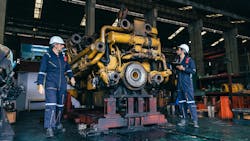Engineering Basics: How to Select Diesel Engines for Critical Process Equipment – Part 2
More from Amin
-
How to Select Diesel Engines for Critical Process Equipment -Part 1
-
Understanding Pressure Vessels: Design, Safety and Uses
-
Uprating and Rerating Industrial Equipment: A Systematic Approach to Higher Loads and Modified Operations
-
Optimizing Centrifugal Pumps: A Blueprint for Chemical Processing Success
In chemical processing environments, diesel engines continue to serve as essential power sources for pumps, compressors, and generators, especially in locations where electric power may be unreliable or where high torque and flexible deployment are priorities. While selecting the right engine is a critical first step, plant performance, emissions compliance, and equipment longevity also depend heavily on the diesel engine’s supporting systems.
Critical Technologies to Consider
Advanced technologies like turbocharging, high-pressure fuel injection, exhaust gas recirculation, and common rail systems play a vital role in enhancing combustion efficiency, reducing particulate matter and NOx emissions, and ensuring smooth operation under varying loads. This part of the series explores those core technologies, offering guidance on how their design and integration impact engine performance and environmental performance in real-world plant applications.
Turbocharger
A single-stage turbocharger, even when effective at medium and high speeds, can’t provide enough air into the engine at the low-speed range. This becomes critical when the rated BMEP of the engine is relatively high. There have been different solutions for this problem such as using an e-turbocharger — either an electric motor-driven turbocharger or supercharger — a variable-geometry turbocharger to make adjustments based on engine speed or using a bi-turbocharger involving two turbochargers (often one smaller and one larger).
Otherwise, the reduction of air flow at the low speed would affect the diesel engine and significantly reduce the produced power and torque. In such a case, a manifold pressure compensation reduces fueling to the engine at low speeds. All these reduce the performance of the engine at low speeds to the level of a naturally aspirated engine. In other words, if the speed falls below the critical threshold, the manifold pressure compensator would reduce the injected fuel and torque, and the engine would hesitate to accelerate.
Fuel Injection System
Higher diesel fuel injection pressures have helped improve the mixture formation due to the higher turbulent kinetic energy and smaller fuel droplets. This also leads to a higher droplet surface, which creates an improved combustion process in the low-medium engine speed range. Also, at medium and high speeds, an increased injection pressure is usually needed to ensure acceptable injection duration.
Major limitations on injection pressure are related to the strength of the nozzle tip. High pressure at the nozzle tip may cause fatigue. The metal between the holes may develop crack propagation from crack-initiation sites within the holes. Other potential sources of failure include the strength of injection pressure parts (such as common rail) and stresses at different key parts of the mechanism. Nearly all modern diesel engines are equipped with common rail injection.
The general requirements on fuel-injection systems of modern diesel engines are:
•Accurate fuel metering shot by shot. Typically, tight tolerances are desirable.
•Increased injection pressures, with some up to 3,000 Bar or more
•Flexible injection rate control
• Reduced nozzle hole diameters
• Increased number of nozzle holes in conjunction with a low port-induced in-cylinder air motion
• Flexible control system and proper diagnostic system
Common Rail-Injection System
The common rail injection allows a choice of injection pressure independently of the engine speed. The beginning and end of the injection can be relative freely chosen. Injection pressure is generated by a high-pressure pump and is available in a common rail for all cylinders.
Electrically operated injectors are used in place of pressure-controlled fuel injectors. In many modern common rail injectors, the old-fashioned magnetic valves are being replaced by piezoelectric actuators (electromagnetic injectors), which are faster than solenoids and are also lighter and better.
Exhaust Gas Recirculation
The exhaust gas recirculation, or EGR, is an important system to reduce NOx generation and emission. This is due to the replacement of air by inert combustion products. In addition, exhaust gas possesses a higher specific heat than air. Both these effects lead to reduced in-cylinder oxygen concentration and reduced temperatures of the cylinder contents. This consequently lowers NOx formation. With increased EGR-rates, NOx-emissions are further reduced. However, the use of EGR may lead to an increase in emissions of particulate matter since EGR usually results in a reduction of the air/fuel ratio.
The EGR loop can be configured over a high-pressure loop (taking the high-pressure exhaust gas before the turbocharger) or in form of a low-pressure loop (taking the low-pressure exhaust gas after the turbocharger). Cooled EGR is desired as it has a higher effectiveness in NOx-reduction than uncooled EGR. However, as the engine coolant should be used to cool the EGR, the cooled EGR results in an increase in heat rejected to the coolant, requiring additional work to cool it. Therefore, overall engine efficiency may be reduced. This should be considered when sizing and selecting the engine cooling system.
Engine Performance Fundamentals
Various internal engine processes — from valve operation to combustion optimization — determine how efficiently the engine converts fuel into usable power while controlling emissions.
Valve Dynamics
The function of the engine valves should allow the maximum amount of charge (air for inlet and exhaust-gas for outlet) through the valves by rapid opening, maximizing average lift and closing as quickly as possible. All these subject valve train components to high accelerations and high dynamic forces, as a result. Cam and follower provide necessary force for opening the valves while valve springs provide necessary forces for valve closing.
As engine operating speeds increase, valve velocity increases linearly, whereas valve acceleration and associated forces increase exponentially.
As the load and speed increase, rapid opening and closing of the valves will lead to the “jerk” due to the sudden changes in forces, which is a sign of rough operation. Therefore, cam profiles are designed to reduce these effects. Ideally, there are no rapid changes, and the profiles are smooth to reduce dynamic forces on the valves.
Another improvement is slowing the movement at the closing phase to keep the valve seating or slapping forces under control. Proper selection of valve springs also can assist in the reduction of seating forces. However, heavy forces and dynamic loadings have been common during valve opening and closing phase.
Combustion at Cylinders
One of problems in some diesel engines, particularly old-school diesel engines, is smoke, especially grey or black smoke that turns into particulate matter. Spraying of the diesel fuel into the swirling air introduces heterogeneity and results in zones of varying combustibility.
Typically, combustion zones are classified as high, medium and low flammability. Moving away from the injector nozzles, there is a spray zone with a spray core and a spray tail and after injection and near edges and far edges of the non-spray zone. The spray core has fuel droplets usually of favorable size, and there is enough oxygen to have complete combustion, resulting in high combustion temperatures and NOx formation.
CO and aldehydes are formed when the temperature and the oxygen content of the fuel-air mixture are not high enough to cause complete combustion (oxidation). This situation occurs in the region between the lean-flame and the lean flame-out area, particularly at high loads when the core becomes more fuel rich.
The spray tail consists of fuel that is injected with relatively low-injection pressures and as a result, has poor penetration and mixing with air, leading to the formation of large droplets that burn ineffectively. This is why having high pressure injection system which can properly inject fuel in fine droplets and distribute the spay with excellent penetration is important.
The near-edge lean-flame region has a reasonable amount of fuel vapor to undergo combustion, and once the ignition occurs, the flame spreads throughout the region, also generating some NOx. The far edge lean flame-out has lean fuel and is primarily responsible for hydrocarbon emissions.
The homogenization in the combustion results in improved operation and higher efficiencies. The fuel droplets should be evenly distributed in the cylinder charge (fresh air and EGR) and autoignition should occur, ideally, at many places around fuel droplets. Still, a high local air/fuel ratio is essential for avoiding soot formation and leading to a lower local temperature and reducing the formation of NOx.
Two primary factors that influence the combustion efficiency are the peak combustion temperature and the mixing characteristics of fuel and charge (fresh air and EGR). Diffusion controlled combustion is a desire type of combustion, and it occurs when the fuel burning rate is controlled by the rate of fuel injection and subsequent mixing with the charge.
Air-Fuel Ratio
Under moderate loads, the hydrocarbons and oxygenates concentration decrease as there is more heat, and fuel burns more efficiently. If the fuel injection increases further due to higher engine loads, the combustion of the fuel in the spray core may become deficient in oxygen, leading to higher hydrocarbons emissions. At such conditions, NOx may begin occur in spray core and at positions within the cylinder in local fuel rich areas. NOx formation is higher for the fuel-rich mixtures than for the stoichiometric, or lean, mixtures due to higher temperatures and pressures.
Diesel engines typically use leaner mixtures with typical AFR of 22:1 – 26:1, and they generate relatively high combustion temperatures, which is primarily because of the higher combustion pressures. The effect of the air/fuel ratio on hydrocarbon emissions is also a function of the engine torque.
Diesel emissions contain hydrocarbons, CO, NOx, aldehydes, PM, among others. The presence of both hydrocarbons and formaldehyde is related to the incomplete oxidation of the fuel. This is usually at high loads, which require burning rich combustion mixtures to generate extra power. The smoke particulates are also an outcome of the inefficient combustion. Their formation was sometime hard to control in old-fashioned diesel engines, even by using lean combustion mixtures, say an AFR of 30:1.
The points of maximum power are the function of different operating parameters, such as BMEP. Typically, points of maximum power might shift toward a higher AFR, such as 23:1 or above. For a 16:1 compression ratio engine, an AFR of around 22:1– 25:1 might appear to be optimal with respect to fuel consumption and emission.
About the Author
Amin Almasi
rotating equipment consultant
AMIN ALMASI is a mechanical consultant based in Sydney, Australia. He specializes in mechanical equipment and offers his insight on a variety of topics including pumps, condition monitoring, reliability, as well as powder and fluid handling and water treatment.

